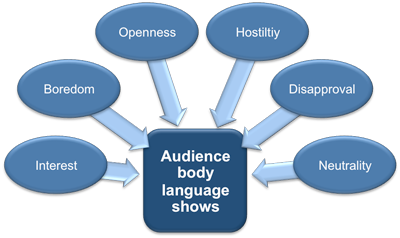Communication Skills - Reading Your Audience
Just as the audience read your own body language you too can read theirs. This continual assessment of their level of attention helps you to understand how engaged they are with the topic and your style of delivery. Is their reaction one of openness, or are they responding negatively to what you are saying? Does the level of eye contact throughout the audience show interest or apathy towards the topic?
When you are making a presentation the best way of staying in control and keeping your audience with you is to keep them interested in what you are saying.
 |
Another complication is that audiences are made up of individuals, who will not necessarily share the same interests, attention span, or boredom threshold. People vary in the way they express these feelings and you should be able to read signs of this from the body language your audience display.
Members of an audience don't usually think of themselves as being observed, and consequently their body language is relatively easy to read. There are a variety of body language signals that you might observe among members of an audience, such as:
• Disapproval
• Hostility
• Openness
• Lack of interest
• Neutrality
• Boredom
Members of an audience can show signs of disapproval or hostility in a number of ways. You may observe people pointedly discussing things with a neighbor, looking at the ceiling or out of a window, or frowning whilst looking at you.
A negative posture - perhaps with an impassive or slightly hostile expression, or with arms folded as if to form a barrier and legs crossed with the person leaning back - suggests resistance to the presenter. However, you should be careful to avoid making judgments based on observing one piece of body language in isolation. For example, crossed legs or crossed arms on their own should not be automatically read as signaling a negative reaction.
A neutral and open attitude is often accompanied by a neutral or slightly friendly facial expression and an upright or slightly forward-leaning seating position. As these people have not yet decided whether or not they agree with your main message you may observe a mixture of gentle nods and shakes of their head as you make your key points. Neutrals should be viewed as a positive resource - it is after all the job of your presentation to win them over.
Someone interested in what you are saying may be smiling and nodding in agreement or frowning in thought, possibly leaning forward attentively. Hands clasped together may also indicate that a person is carefully considering what you are saying.
If boredom is affecting any members of your audience this may manifest itself in reversion to common habits - such as fidgeting with personal belongings like glasses, watches, pens, or earrings. Whilst looking at a watch or clicking a pen may demonstrate boredom don't confuse these signs with such things as the chewing of the end of a pen, which may indicate thoughtfulness.
Members of the audience who become bored may also whisper among themselves, rustle papers, scribble aimlessly on notepads, leaning back with their hands behind their heads, and even make audible sighs.
Recognizing both positive and negative signals from your audience should not change your planned presentation fundamentally. Your message and the material with which you are communicating it should have been carefully prepared and radical changes will almost certainly not be practical.
The real point of reading signals from your audience is that it can help you to judge who you have on-side, who is opposing your point of view, and who has yet to decide. This should help you to focus your message where it can have maximum impact, using your transitions to talk round those that can be swayed, whilst keeping your supporters with you and trying not to alienate the opposition.
You may also be interested in:
Giving a Management Presentation | Styles of Presenting | Cue Card Guidelines | Developing a Persuasive Delivery Style | How to Rehearse | Retaining Control in a Presentation | Question and Answer Session | Importance of the Presentation Venue | Presentation Venue Layout.



